Assessment

Key Takeaways
The British Columbia K-12 Student Reporting Policy provides information on assessment practices (assessment as, for, of learning), ways and when teachers need to communicate student progress and support for the reporting process.
I decided to try using the Magic School AI Text Summarizer to provide the following points about the document:
- The document outlines guidelines for communicating student learning in kindergarten to grade 12 in British Columbia.
- It emphasizes the importance of clear, meaningful and timely communication of student progress.
- The guidelines aim to support student well-being, engagement, and continuous growth.
- Educators are encouraged to use multiple forms of assessment to inform communication with students and parents.
- The document highlights the need for ongoing communication between teachers, students, and parents.
- It stresses that assessment practices should be equitable and transparent to all stakeholders.
- The guidelines include information on reporting timelines and grading practices.
- It provides recommendations on reporting.
Another way to see this document summarized is through the following link: https://www2.gov.bc.ca/assets/gov/education/administration/kindergarten-to-grade-12/criteria-and-considerations-for-written-reports-for-educators.pdf
Below are the key takeaways I took from the K-12 Student Reporting Policy:
Types of Reporting: Written, Informal, and one summary.
Frequency of Reporting (5 learning updates total):
“Two written Learning Updates must be provided in writing, and can include either digital or printed documents” (K-12 Student Reporting Policy, 2024, p. 24). Below is an image from the document that will support me as a future teacher to ensure I am meeting the requirements for the written learning updates (Report Cards):
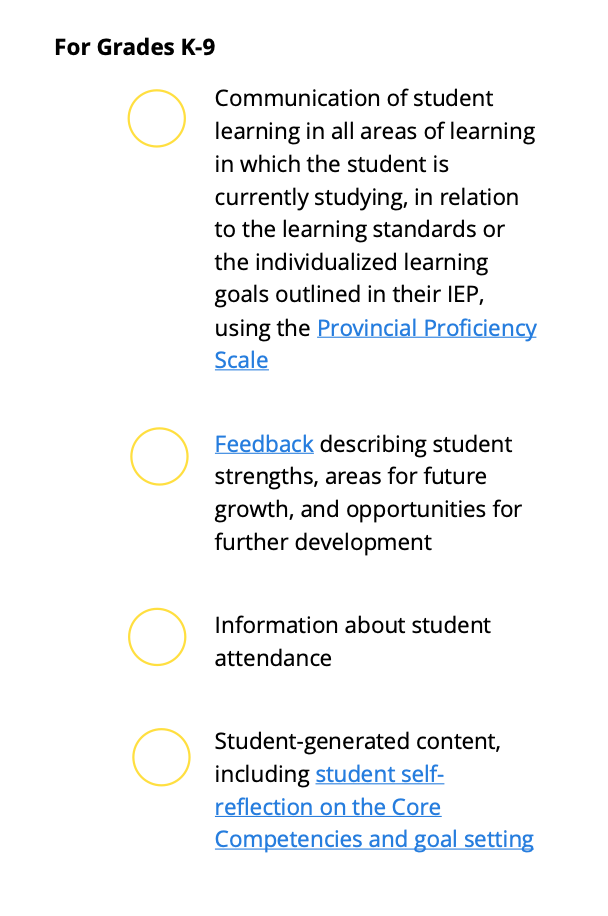
“Two informal Learning Updates can be provided in a variety of formats, including conferences, in-person or virtual discussions, telephone calls, e-mails, portfolio entries, or written summaries” (K-12 Student Reporting Policy, 2024, p. 24). I plan to have an open house one evening near the beginning and end of the year and use Seesaw throughout the year so caregivers can continually see their child’s growth.
“One Summary of Learning at the end of the school year must be provided in writing, and can include either digital or printed documents” (K-12 Student Reporting Policy, 2024, p. 24).
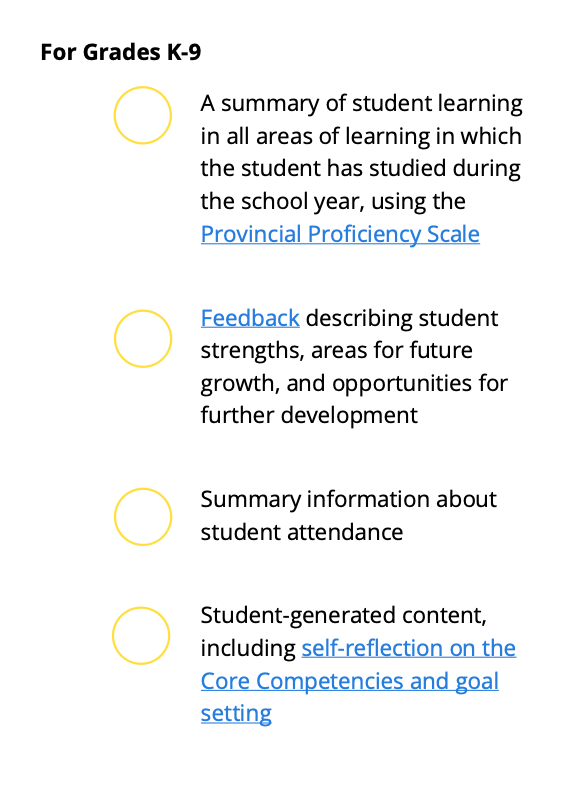
Summary Report (ie. Report Cards): I found the K-12 Student Reporting Policy helpful because it has an example report card on pages 46-48 to guide my practice (2024).
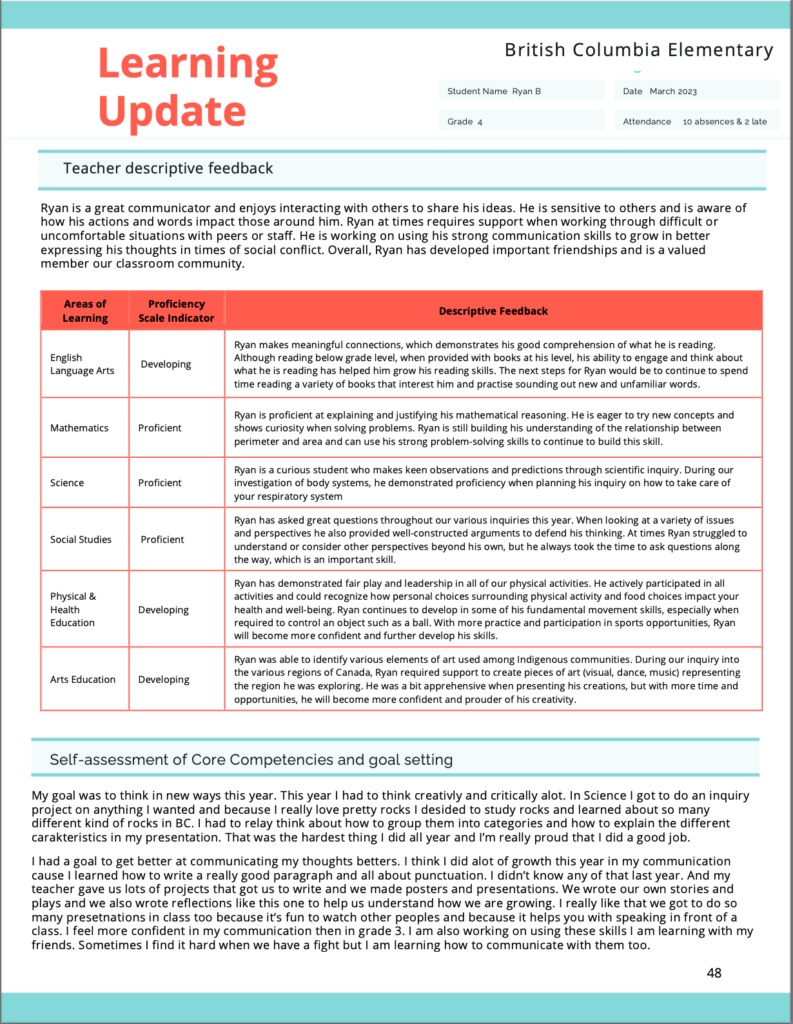
Writing Descriptive Feedback:
I learned two helpful things from this section of the document in regard to writing descriptive feedback:
- Use plain language (ie. most instead of “the majority of”).
- This document provides sentence starters that work well with each designation of the proficiency scale to use in your report card writing:

Triangulation of assessments: This means we need to collect observations, conversations, and products over time. These three different assessment approaches ensure that the teacher has the best big picture to be able to assess their students to the best of their ability and the most fairly. Below is a video showing how one teacher has done this:
Self-Reflection of the Core-Competencies:
Lastly, it is critical that teachers include student-self reflections on the core competencies in their reporting. Below is an example of one I have created as an example for a grade three student:
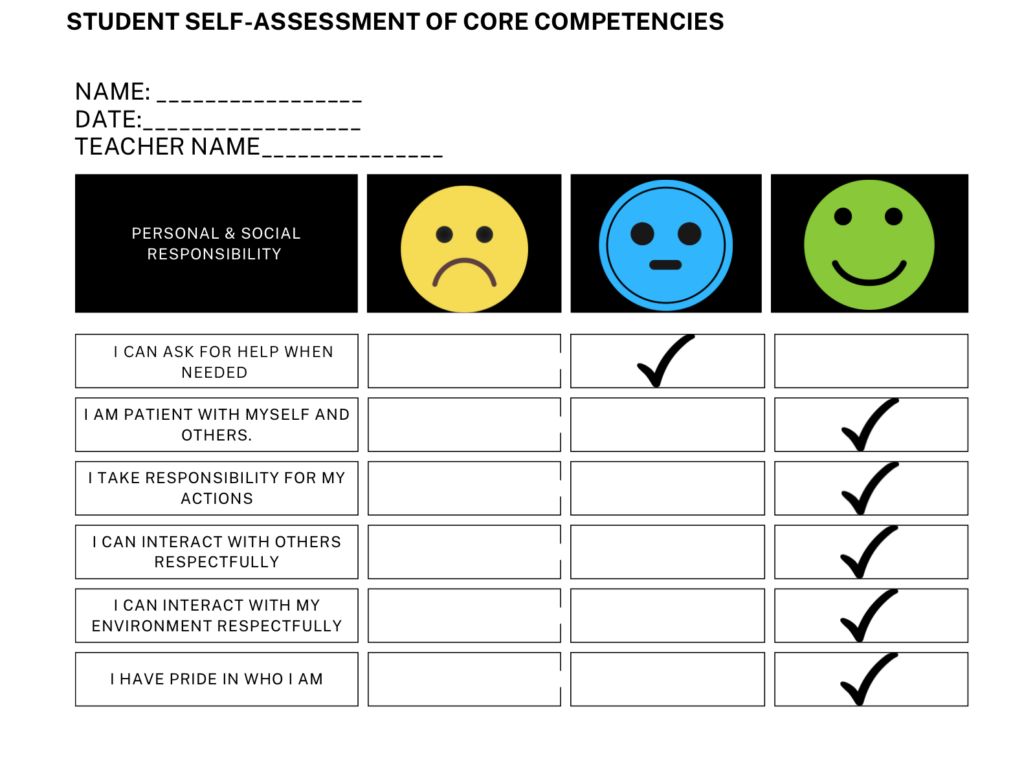
I was initially nervous of how I would make the self-assessment; however, once looking at the BC Curriculum Core Competencies and realizing how the profiles break them down into digestible language I was relieved. Often they were even written in “I can” statements which makes it very easy to create a self-assessment directly from the curriculum.
Attendance: It is mandated to include information about student attendance on their report card.
BC Proficiency Scale:
The proficiency scale is used in British Columbia in grades K-9. Each student in BC falls within this scale unless the teacher has insufficient evidence of learning in which case they can report (IE). The proficiency scale is rated from emerging to extending as follows:

Link to the document: https://www2.gov.bc.ca/assets/gov/education/administration/kindergarten-to-grade-12/unpacking-the-proficency-scale-support-for-educators.pdf
Why the shift from grades to a proficiency scale?
- “Views learning as ongoing, rather than signalling that learning is done” (Unpacking the proficiency scale, 2024, p. 1).
- “Values growth and most recent evidence of learning” (Unpacking the proficiency scale, 2024, p. 1).
- “Provides feedback, to both students and their parents and caregivers, on where the student is in their learning and how to help them move forward” (Unpacking the proficiency scale, 2024, p. 1).
- “Supports lifelong learning by shifting the focus from getting marks to developing competencies” (Unpacking the proficiency scale, 2024, p. 1).
- “Maintains high provincial standards, helping all students attain proficiency in their learning” (Unpacking the proficiency scale, 2024, p. 1).
- “Is inclusive of all learners, focusing on strengths and next steps for each individual student” (Unpacking the proficiency scale, 2024, p. 1).
How do teachers use the proficiency scale?
Teachers use the proficiency scale to evaluate student progress against the BC curriculum learning standards. See the below steps which help teachers plan their teaching to support students to fulfill their learning goals successfully and reflect on where they are to support their next steps:
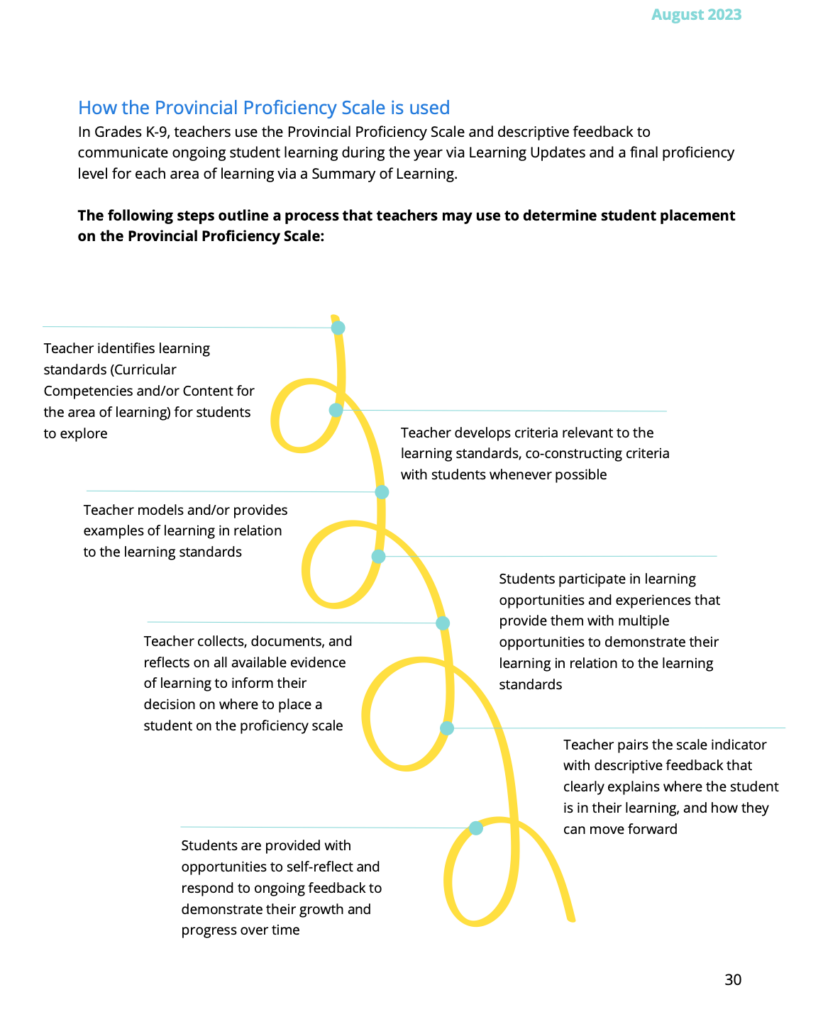
Example of a Report Card Comment for Literacy
Below is an example of a report card comment I created for English Language Arts based on the BC proficiency scale and student reporting policy in my assessment course (student name and ideas are made up):
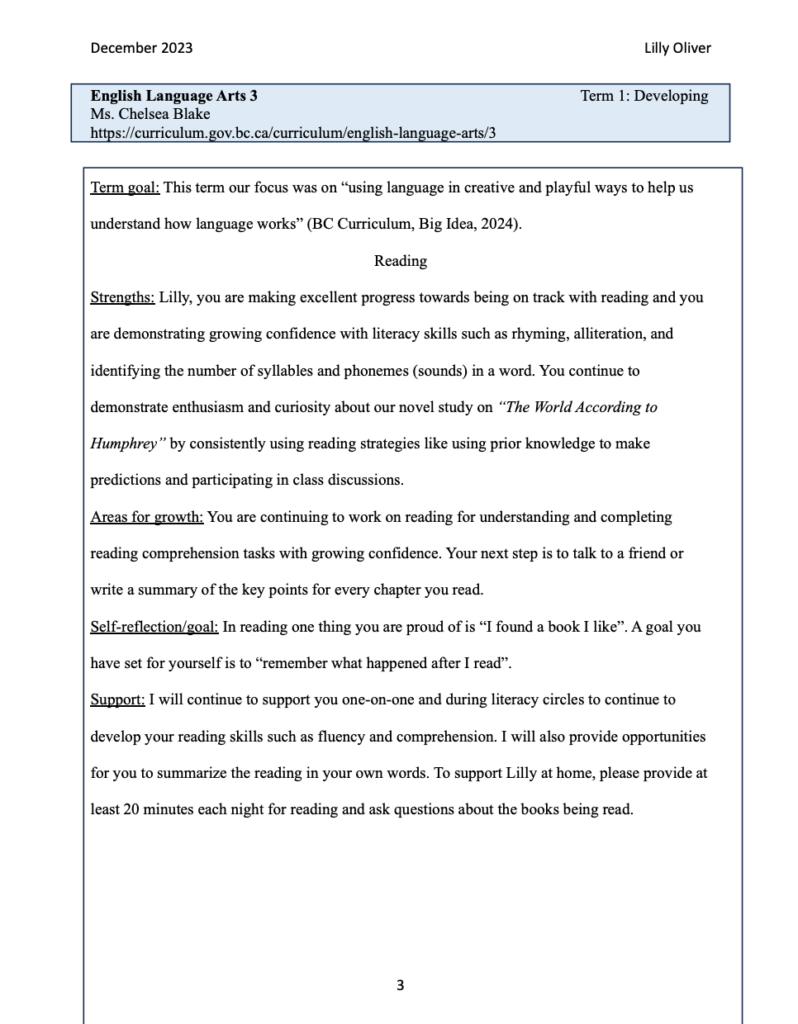
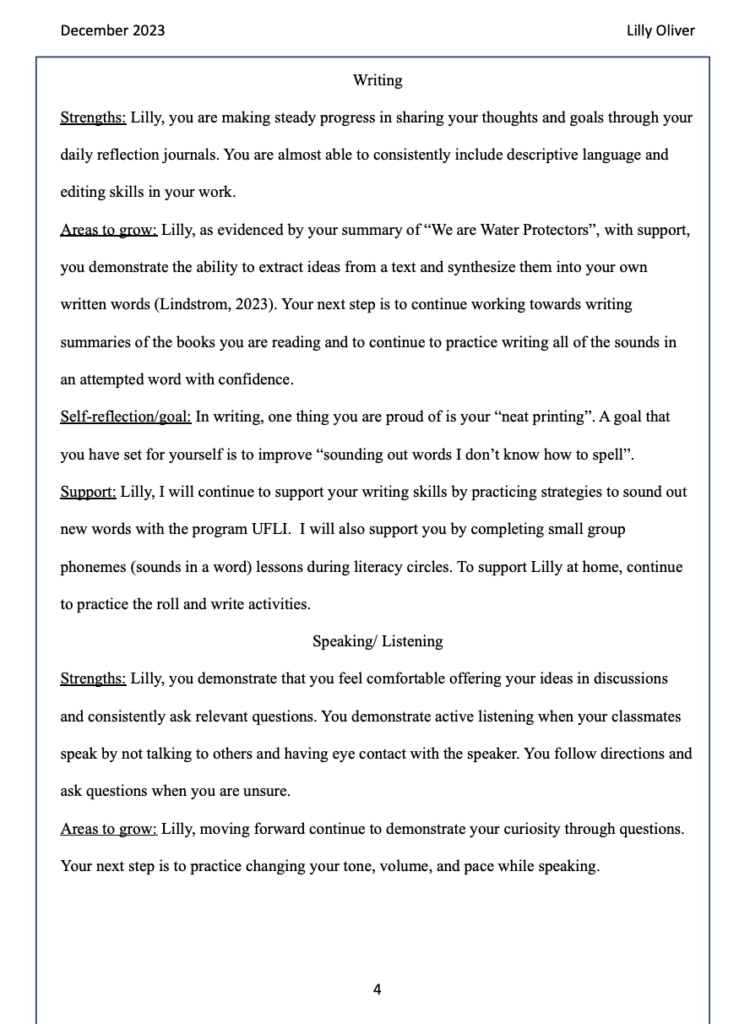
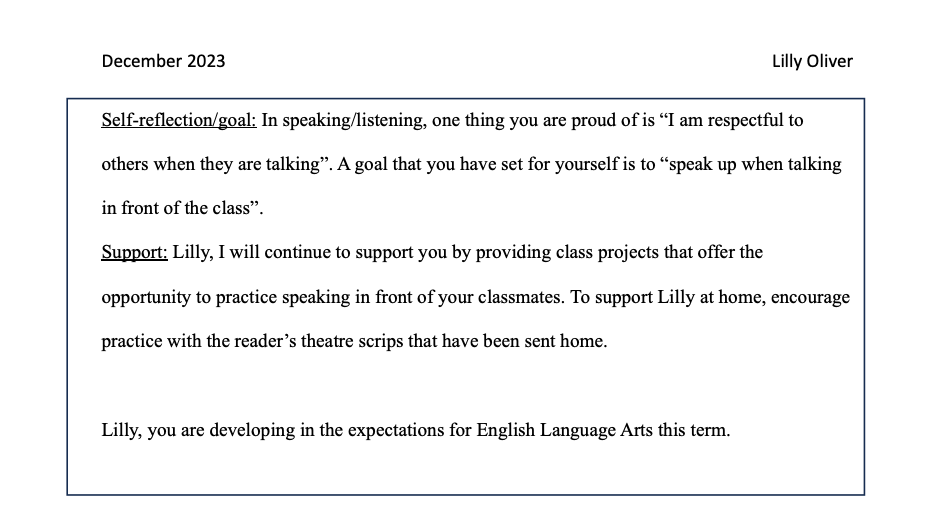
My peers Morgan Tank and Emily Sartorel wrote a beautifully done report card comment that I want to keep for reference in the future. They gave me consent to add it to this blog post so that I can refer to it in my future practice:
“Suzy is developing in term 2 for English Language Arts. Suzy continues to gain confidence in our Guided Reading groups and works well and contributes towards the weekly activities that take place in those groups. She has been working on spelling lists for short and long vowel sounds. I encourage Suzy to continue working on her at-home reading practice and the spelling lists that get sent home on Fridays. For the month of February we had a read-a-thon and I was impressed by Suzy’s courage to read beyond her comfort level. She really gravitates towards animal books. Moving forward I encourage Suzy to practice sounding out words, use her expression when reading and to slow down. I am very proud of how far Suzy has come, and I look forward to seeing her continue to grow in English Language Arts” (Sartorel & Tank, 2024).
Conclusion: The reporting and assessment process is very complex; however, the documents shared in this blog post help us as educators understand our ethical duty to assess and report on our students progress to ultimately support their learning.
~Chelsea
Backwards Design: Assessment
During one week of our science course, we focused on formative and summative assessment strategies. My “aha” moment was the idea of Backward Design for unit planning. I now realize WHY it is so important. As educators, we need to have the end goal in mind so that we plan and create assessments of/as/for learning and a unit that will support students in reaching the learning objectives. Too often we find activities to lead us to a goal when we need to be focusing on the goal and then finding the appropriate strategies to get there. Jennifer Gonzalez shared the basics of this through a podcast called “148: Backward Design: The Basics“ on Apple podcasts.
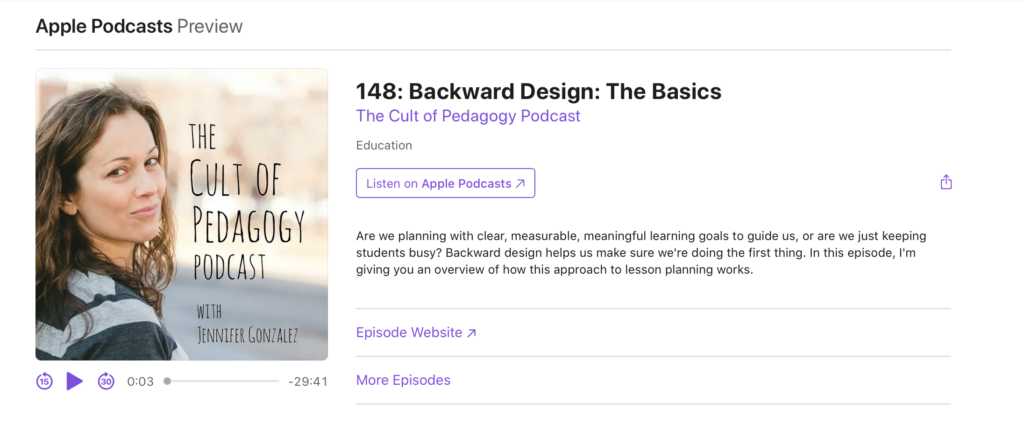
My key takeaways of how to implement Backward Design:
- Identify what students should know and be able to do by the end of the learning cycle (Gonzalez, 2020).
- Create an assessment to measure that learning (Gonzalez, 2020).
- Plan a sequence of lessons that will prepare students to successfully complete the assessment (Gonzalez, 2020).
I loved the connection that our instructor shared with us during the podcast which was that here in BC we should be starting with the Big Ideas and questions from the BC Curriculum then create an assessment to measure that learning and finally create the lessons to support that learning.
I wanted to look a little further into backward design and by doing this I found a great video by Shelly Moore called “Backwards Design: A great way to move forward!”. I love how she emphasizes that the importance of offering multiple pathways to reach the goal that will work for all students. Please see the below video.
Thinking about backwards design, I have initiated the process of creating my science unit plan. Below is what I have so far:
- Starting with the end in mind: The grade 5 science big idea: “Multicellular organisms have organ systems that enable them to survive and interact with their environment” (BC Curriculum, 2024). A question within the Big Idea that I want students to know is “How do organ systems interact with one another?” (BC Curriculum, 2024). Lastly, the content I want them to know is basic structures and functions of the digestive, musculoskeletal, circulatory, and respiratory systems (BC Curriculum, 2024).
- Next, I will work on creating a summative assessment rubric that will have criteria based on the end goal.
- After that I will begin formulating the concept/lesson ideas to guide students there. At the end of the semester I will share my unit plan on this blog to show you what I create with my first time trying a backward design!
~Chelsea
References
AI for teachers – lesson planning and more!. MagicSchool.ai – AI for teachers – lesson planning and more! (n.d.). https://www.magicschool.ai/
connect2learning. (2024, February 23). Clapping exercise 2019. Vimeo. https://vimeo.com/351056132/1f1bd343e7?share=copy
Curriculum. (n.d.-a). https://curriculum.gov.bc.ca/
Davies, A. (2020). Making classroom assessment work. Davies Duncan Holdings Inc.
K-12 student reporting policy. (n.d.-c). https://www2.gov.bc.ca/assets/gov/education/administration/kindergarten-to-grade-12/k-12-student-reporting-policy-communicating-student-learning-guidelines.pdf
Moore, S. (2019, April 1). Backwards design: A great way to move forward!. YouTube. https://www.youtube.com/watch?v=mLKHaNo98Ts
Professional standards for BC educators. (n.d.-f). https://www2.gov.bc.ca/assets/gov/education/kindergarten-to-grade-12/teach/teacher-regulation/standards-for-educators/edu_standards.pdf
Unpacking the proficiency scale- support for educators. (n.d.-k). https://www2.gov.bc.ca/assets/gov/education/administration/kindergarten-to-grade-12/unpacking-the-proficency-scale-support-for-educators.pdf
YouTube. (2009, October 21). Assessment: Using triangulation in the classroom. YouTube. https://www.youtube.com/watch?v=wh3hj9pGv9U